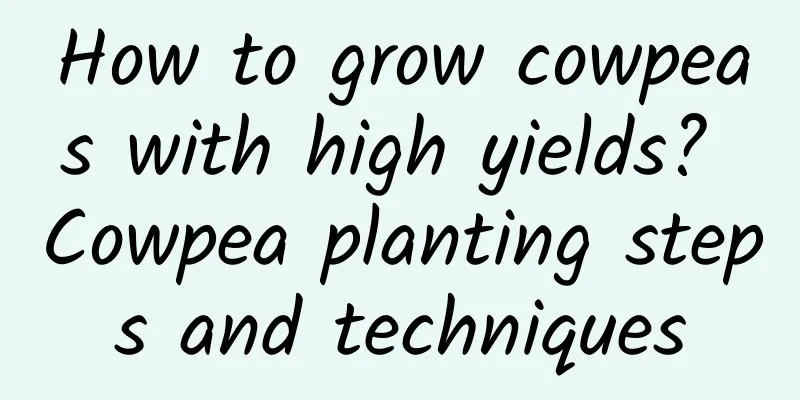How to grow cowpeas with high yields? Cowpea planting steps and techniques

|
How can we get high yield of cowpea when we grow it? Let me tell you today: 1. Sowing time.The best time for direct seeding of cowpea in the spring is about 10 days before the local late frost, when the soil temperature should be stable at 10-12oC. 2. Select suitable varieties.The basic principles of seed selection are: first, select high-quality varieties that are not strict with sunlight requirements and can be cultivated in three seasons. Second, select high-quality varieties that are resistant to diseases and insects and have strong resistance to stress, so as to obtain stable and high yields. 3. Prepare the land and apply base fertilizer.Cowpea fields should be cultivated and ridged, with adequate basal fertilizers, especially phosphorus and potassium fertilizers. If conditions permit, a small amount of cake fertilizer or chicken manure should be applied as basal fertilizer on the ridge surface. In the south, high ridges are used, with a ridge width (including ditch) of 1.2-1.4 meters and a ditch depth of 25-30 centimeters to facilitate drainage. Two rows can be planted in each ridge to facilitate rack harvesting. 4. Sowing and raising seedlings.It is advisable to choose a sunny day for sowing. Dry seeds can be sown directly or by seedling transplanting. Under normal circumstances, seedling transplanting increases yield by 25-35% compared to direct sowing. When sowing, the thickness of the soil covering the seeds is 2-3 cm, and then covered with a small arch film for heat preservation. After the seedlings emerge from the soil, strengthen ventilation and cooling to prevent leggy growth. When the first pair of true leaves are exposed but not unfolded, they can be planted in the field. The density is 3300-3800 holes per mu, with 3 plants per hole. In summer and autumn, cowpeas are mostly sown directly. Before sowing, water the bottom of the tree, then hoe and loosen the topsoil, sow 3-4 seeds per hole, and cover the soil with about 3 cm. In order to prevent soil moisture evaporation, it is best to cover with a small amount of grass. No watering is required before emergence, otherwise it will cause seed rot. 5. Field management.(1) Install a rack to guide the vines. When the plant grows to 17-33 cm and is about to sprout, install a rack in time. Generally, bamboo poles are inserted into a "human" shape, with a height of 2.2-2.3 meters. One pole is inserted in each hole and slightly tilted inward. Every two poles intersect, and a bamboo pole is placed at the intersection of the upper part as a crossbeam, forming a human shape. The vines are guided onto the rack at noon or in the afternoon on a sunny day. (2) Remove buds and top. When the side branches below the first inflorescence grow to 3 cm long, they should be removed in time to ensure that the main vine is strong. The side branches at each node above the first inflorescence of the main vine should be pinched after leaving 2-3 leaves to promote the formation of the first inflorescence on the side branches. When the main vine grows to 15-20 nodes and reaches 2-2.3 meters in height, cut off the top to promote the formation of flower buds on the lower side branches. (3) Fertilizer and water management. After the cowpea seedlings are fully grown or transplanted, it is usually necessary to carry out inter-cultivation, loosening the soil and topdressing. About 750 kg of 20% decomposed human feces and urine are applied per mu. When the seedlings reach 25-30 cm in height, 15 kg of urea is used per mu and watered. After the first inflorescence begins to pod, it is advisable to increase the amount of topdressing and keep the soil moist at all times. Generally, 30-40% decomposed human feces and urine are used to irrigate the roots, and topdress once every 5-7 days for 3 times in a row. 6. Prevent and control diseases and insect pests.The main diseases of cowpea are coal mold and rust. The main pests are cowpea pod borer and aphids. Coal mold and rust. In the early stage of the disease, remove the diseased leaves in time to reduce the spread of the disease, and spray as soon as possible. The main agents are 50% carbendazim 500 times liquid, 75% thiophanate-methyl 600 times liquid, spray once every 7-10 days, and spray 2-3 times in a row. Cowpea pod borer. After entering the flowering period, when the petals open at 7-9 am, aim at the flowers and spray the following agents in time: 80% dichlorvos emulsion 800 times liquid, spray once every 5 days or so, and pick up the fallen flowers in the field at the same time. You can also spray the plants after 7 pm. Aphids. You can spray 40% dimethoate emulsion 1000 times liquid, spray once every 7 days or so, and spray 2-3 times in a row. 7. Harvest.Spring-sown cowpeas can be harvested 8-10 days after flowering, and summer-sown cowpeas can be harvested 6-8 days after flowering. When the pods are uniform in thickness, the beans on the pods are not bulging, and they meet the commercial pod standards, it is the right time to harvest. When harvesting, the flowers on the upper part of the inflorescence should be protected, and the flower stalks should not be picked together. Generally, harvest once a day during the peak pod period, and once every other day in the later period. |
<<: How to stir-fry cowpeas? Steps to cook cowpeas
>>: Cowpea disease characteristics and control methods
Recommend
The efficacy and function of Ligularia punctata
Spotted Ligularia is a plant with particularly be...
The effects and side effects of wild dandelion
Every spring, many people like to eat some wild v...
Nutritional value and benefits of sweet potatoes
Sweet potato is a coarse grain, but the nutrition...
Weifang radish planting time Weifang radish planting technology and methods
Weifang radish is a very famous radish. Many peop...
How is Kinenko? Kinenko reviews and website information
What is Quinenco? Quinenco is a famous Chilean min...
How is New Europe Flea? New Europe Flea Reviews and Website Information
What is New Europe Flea? New Europe Flea is a seco...
How is the South African Car Insurance Network? Reviews and website information of the South African Car Insurance Network
What is Car Insurance South Africa? Car Insurance ...
The efficacy and preparation of ginger jujube tea
Do you know the effects and methods of ginger and...
The efficacy and function of rock ear
Rock ear, also known as stone wall flower or ston...
How to cook lentils with pork residue
Braised lentils with pork scraps is delicious. My...
The practice and efficacy of papaya and tremella soup
Papaya and Tremella soup has the effects of beaut...
How to eat instant bird's nest How to eat instant bird's nest
Instant bird's nest is a convenient food. It ...
How to pickle red pepper and soybean
Red pepper and soybean is a delicious and appetiz...
The efficacy and function of Songxia
Songxia is a special plant similar to cactus. Thi...
How is the Minecraft official forum? Minecraft official forum reviews and website information
What is the Minecraft Official Forum? The Minecraf...









